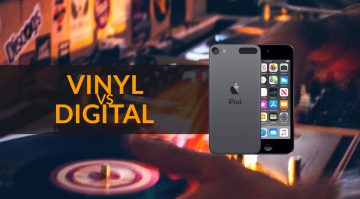Hot Topic: Audiophiles vs Gen Z – Are you a vinyl head or a TikToker?
In this post, we’ll be discussing various listening formats and asking readers an important question: How do YOU consume music?
As this topic has so many facets, we decided to get the opinions of both our Editor-in-chief, Bob Malkowski, and our Tech editor, Stefan Wyeth.
To make sure we’re on the same page, we’ll take a brief look at the various media formats available today, before we open it up to our panel. Let’s get into it!
Physical listening formats
Physical formats include all the obsolete mediums of yesteryear. From vinyl to cassette, CD, and MiniDisc, even digital downloads require a storage medium. Although streaming is more convenient, the sale of physical units created the business model for the music industry that produced some of the greatest artists of all time.
Digital streaming platforms
Streaming conveniently provides a huge database for the listener. However, the artist generally gets the short end of the stick in the arrangement. This is because stream count as a metric provides very little value for the most part. Instead, the priority of platforms is to keep users on the app for advertising revenue and in-app purchases.
Live music
In recent years, we’ve seen the rise of online platforms like Boiler Room and NPR Music both pre and post-pandemic. They offer a global audience the chance to get a taste of what their favourite artists are like on stage. This has quickly become a powerful medium for establishing a lasting connection with fans and exposing artists to new audiences.
You are currently viewing a placeholder content from YouTube. To access the actual content, click the button below. Please note that doing so will share data with third-party providers.
What are your thoughts on physical mediums? Is vinyl still relevant?
BM: For me, a physical format only makes sense if it provides the listener with a unique experience. I’m not sure that Compact Disc makes much sense in 2023. Terrible artwork, and audio fidelity that can be bettered by streaming; it’s somewhat the worst of both worlds.
Analogue formats, however, offer something unique.
Vinyl, in particular, offers a very different experience to digital media. Regardless of whether you think vinyl sounds “better” it certainly sounds “different”. To a lesser extent, you can say the same of cassette tapes too! I’m really enjoying the re-discovery of cassette tapes as a quick, cheap medium for selling at gigs!
Having a collection of vinyl records is an investment, but one you can keep for life. They’re beautiful physical artifacts. Buying music in a physical format is a statement purchase I think.
SW: Although sales figures of formats like vinyl continue to rise each year, it remains a niche medium when we look at how the majority of us listen to music.
However, there are sects of music culture like electronic music where vinyl remains a prestigious part of the art form. The fact that pressing plants and mastering houses have been running since the late 1980s through the rise of dance music culture is interesting.
I think the overall expense as well as the level of technical skill and analogue equipment required to produce vinyl provides a yardstick for music quality standards and it’s kept this alchemical practice alive all these years.

Discogs is one of the top platforms for physical music formats. · Source: Discogs
How about digital streaming platforms? Does uncompressed audio streaming matter?
BM: This month, I’ll likely be cancelling my Hi-Res streaming account subscription. Why? The same reason I’ve abandoned all of those Hi-Res, Audiophile streaming accounts – the experience sucks!
Streaming platforms primarily serve two purposes: convenience and to allow the discovery of new music. Those Hi-Res platforms are great if you want to sit at home and listen to Steely Dan all day. And make no mistake, the audio quality of those platforms can be mindblowing!
Increasingly though, I found myself listening to the same old albums, because I wasn’t discovering anything new. Equally, Hi-Res playback just isn’t reliable when on the go; it’s no good for listening in the car for example.
I’ve somewhat reluctantly gone back to Spotify. The audio quality isn’t as good, but it’s reliable and I’m discovering way more new music than I ever have done.
SW: Audio fidelity matters to very few of us, and this has a negative effect on the music we listen to. Everyone has the power to release their own music, however, actually getting your music heard on different platforms has serious financial implications.
No one can deny the convenience of being able to think of any song and listen to it in seconds, but it’s the experience that suffers. This is because most of us are listening to music on earbuds or laptop speakers that offer limited frequency range and dynamics.
We have so many “lifestyle” listening devices marketed to us by tech companies. So as listeners, we can combat this by simply researching what makes a decent set of speakers or headphones.

Catch up with Spotify‘s Stream On 2023 event. · Source: Spotify
With the rise of live streaming, the post-pandemic era of live music is looking promising, but what can be improved?
BM: The problems being faced by live-streaming performances are many of the same challenges the broadcast industry faced four or five decades ago. How do you convey that live sound and live atmosphere over a broadcast feed?
Having briefly worked in TV as a broadcast sound engineer, the disparity in resources between traditional broadcast channels and live streaming is staggering. For example, most live shows and concerts shown on TV will rely on completely independent stage splits run off to a separate outside broadcast truck to be independently mixed for broadcast.
That level of detail may not be necessary for wholly electronic acts, but it certainly poses a technical challenge when dealing with traditional guitar bands.
SW: Mixing music on a PA system has a completely different methodology to mixing for live streaming, so the quality often suffers as a result. It’s up to artists to seek out engineers with the skills to pull this off consistently and the audience will catch on.
I find the raw, unprocessed audio approach used by platforms like NPR extremely limiting. It’s very much masked by the appeal of being able to see your favourite artists “in the flesh” which tends to make both artists and audiences lazy.
Artists continue to be discovered this way, so it’s up to them to get more involved with the sonics of their music. Don’t be afraid of effects pedals, folks!

TikTok‘s parent company ByteDance has transformed the Music Industry. · Source: ByteDance
Find out more:
- Learn about vinyl sampling
- All about digital platforms
Videos:
You are currently viewing a placeholder content from YouTube. To access the actual content, click the button below. Please note that doing so will share data with third-party providers.
You are currently viewing a placeholder content from YouTube. To access the actual content, click the button below. Please note that doing so will share data with third-party providers.
You are currently viewing a placeholder content from YouTube. To access the actual content, click the button below. Please note that doing so will share data with third-party providers.
You are currently viewing a placeholder content from YouTube. To access the actual content, click the button below. Please note that doing so will share data with third-party providers.
You are currently viewing a placeholder content from YouTube. To access the actual content, click the button below. Please note that doing so will share data with third-party providers.
You are currently viewing a placeholder content from YouTube. To access the actual content, click the button below. Please note that doing so will share data with third-party providers.
One response to “Hot Topic: Audiophiles vs Gen Z – Are you a vinyl head or a TikToker?”
 4,3 / 5,0 |
4,3 / 5,0 | 







Arguably CD *is* the best of both world. Some cases are work of art and it sounds as good as human ears can percieve it.
Whereas vinyls are finicky , expensive, polluting, contains very little data, and objectively sound bad (you cannot reproduce all hearable frequencies and dynamics on a vinyl, period. (You can however, make a CD sound like a vinyl no problem))
The only perk is the big artwork… fine… I’d love to buy big artworks… but why do we need to stick a big sub-par format in the middle ?